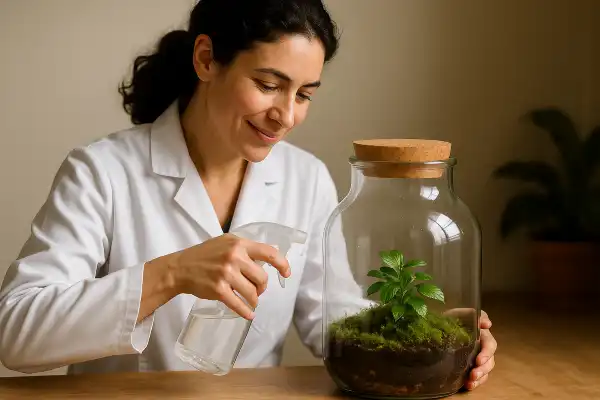How to water a terrarium puzzles both beginners and experienced plant enthusiasts because these miniature ecosystems operate differently from traditional houseplants. The delicate balance between too much and too little moisture determines whether your glass garden thrives for years or succumbs to common problems like root rot and fungal infections.
During my studies in plant micro-ecosystems at Universidad Nacional Autónoma de México, I discovered that terrarium watering resembles orchestrating a symphony—each element must work in perfect harmony. Unlike the predictable watering schedules of potted plants, terrariums demand observation, patience, and understanding of their unique water cycles.
How to water a terrarium?
Proper terrarium watering depends entirely on whether your container is open or closed, with closed terrariums requiring water only every few months while open terrariums need weekly attention. The fundamental difference lies in how each type manages moisture: closed terrariums create self-sustaining water cycles through condensation, while open terrariums lose moisture through evaporation and require regular input.

Understanding terrarium water cycles
Closed terrariums function as complete ecosystems where water moves from soil to plants through root uptake, then releases into the air through transpiration, condenses on glass walls, and drips back into the substrate. This natural recycling process means that once properly established, closed terrariums rarely need additional water.
Open terrariums lack this recycling capability because increased airflow causes moisture to escape into the surrounding environment. These systems require regular monitoring and water input, much like traditional container gardens.
Recognizing when your terrarium needs water
The most reliable indicator for both terrarium types involves checking substrate moisture and observing condensation patterns. Tropical terrarium substrate should feel moist to the touch but never wet, and healthy closed terrariums display condensation beads throughout the soil layer.
Proper closed terrarium condensation appears on one side of the container about once daily, typically during morning and midday temperature peaks. A well-watered closed terrarium shows fogging in the morning that clears by late afternoon.
Signs your terrarium needs water include:
- Substrate feels completely dry when touched
- Moss changes from vibrant green to pale yellow
- Plants appear wilted, dry, and pale
- No condensation appears on glass walls for several days
- Substrate shrinks and changes volume
Watering techniques for closed terrariums
Use a spray bottle set to “stream” mode and spray the interior glass walls, allowing water to run down the sides rather than spraying directly onto soil. This technique prevents disturbing the substrate while ensuring even moisture distribution.
Apply water using a syringe or pipette, placing 2-3 tablespoons directly at plant bases while avoiding leaves. Start conservatively—adding too little water is safer than adding too much, since excess water cannot drain from closed systems.
When establishing a new closed terrarium, add water one spoonful at a time until condensation patterns develop, indicating proper moisture levels. Monitor for several days after watering to ensure the water cycle establishes correctly.
Watering techniques for open terrariums
Open terrariums typically require weekly watering, though frequency depends on environmental conditions and plant types. Desert plants like succulents in open terrariums need water only when soil becomes completely dry.
Use a spray bottle or measure water by tablespoons, checking soil dryness before each watering session. Plants preferring humid conditions, such as ferns and fittonias, should never have completely dry soil but avoid soggy conditions.
Misting provides supplemental humidity for tropical plants in open terrariums. Apply fine mist to plant leaves and interior surfaces, adjusting frequency based on seasonal conditions—more often in warm months, less frequently during cooler periods.
Troubleshooting watering problems
Overwatering presents the most common terrarium challenge. Excess water in closed systems leads to root rot, turning roots brown and mushy while cutting off oxygen to plant systems. Signs include persistent fogging that obscures plants for multiple days and yellowing vegetation.
Remove excess water using a pipette from the drainage layer, or leave the terrarium open until water evaporates naturally. Speed evaporation by wiping interior glass surfaces with clean, lint-free cloths.
Mold appears as white fluff on leaves, indicating excess moisture and poor air circulation. Remove affected vegetation immediately and increase ventilation by opening the container for several hours daily until conditions stabilize.
Water quality considerations
Rainwater provides optimal nutrition without disrupting ecosystem balance, while demineralized water serves as an acceptable alternative. Tap water works adequately but may leave mineral deposits on glass surfaces over time.
Air plants in open terrariums benefit from distilled water applied weekly, spraying from sides rather than directly overhead. Always avoid water that has passed through water softening systems, as increased sodium content harms most terrarium plants.
Seasonal and environmental factors
Typical closed terrariums require water supplementation every couple of months, with increased frequency if regular ventilation occurs. Warmer months increase evaporation rates, requiring slight increases in watering and misting frequency.
Humidity levels in your home affect watering needs significantly. Dry indoor environments increase water requirements for open terrariums, while humid spaces like bathrooms reduce watering frequency. Monitor your terrarium’s response to seasonal changes and adjust accordingly.
Essential drainage considerations
Every terrarium requires a drainage layer of rocks and horticultural charcoal at least ¼ inch deep to prevent water from pooling around roots. This foundational layer allows excess moisture to collect safely away from plant root systems, preventing the anaerobic conditions that cause root rot.
Proper substrate selection complements drainage systems. Choose substrates with high water retention but excellent drainage properties, ensuring they remain moist but never waterlogged. Avoid standard potting soils, which often retain too much moisture for terrarium environments.
Conclusion
In 2020, I carefully watered my newest closed terrarium—a moss and fittonia arrangement in a vintage apothecary jar. Using the spray-and-observe technique, I added just enough moisture to activate the water cycle without overwhelming the delicate balance. Watching condensation form the next morning confirmed successful establishment, marking another step in my terrarium-building journey. These experiences continue shaping the knowledge I share with fellow enthusiasts seeking to master the art of terrarium care.
